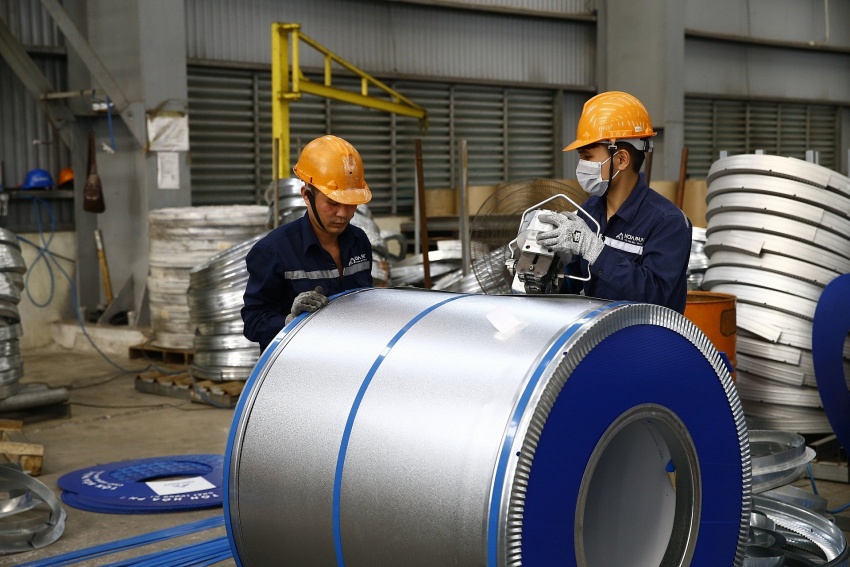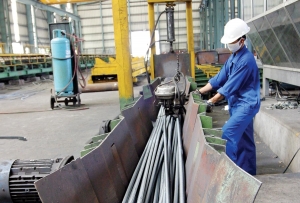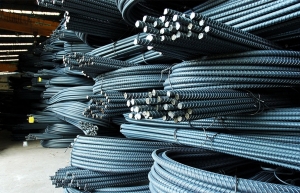Vietnam's steel sector revitalised in 2024
 |
| Vietnam's steel sector revitalised in 2024. Photo: Duc Thanh |
Le Hai Thanh, an analyst at MBS, said, “Steel is a sector with existing recovery prospects, thanks to the global steel price increase, warming demand in the domestic market, and the potential for heightened profit margins as input factors such as coal and ore are predicted to decrease slightly.”
FPT Securities also suggests that 2024 is poised to be a prosperous one for the Vietnamese steel industry, with domestic market consumption expected to reach 18.6 million tonnes, marking an 8.7 per cent increase compared to 2023. This would signify the first positive growth in steel consumption within the domestic market after two consecutive years of decline.
The growth is attributed to a robust push in public investment, exemplified by the initiation of 12 public projects by the Ministry of Transport at the end of 2023.
Furthermore, the MoT is gearing up to launch at least 19 transport projects in 2024, continuing its efforts to bolster transportation infrastructure. These initiatives include upgrading the Khe Net pass railway route on the Hanoi-Ho Chi Minh City railway line, enhancing the Quy Nhon channel for 50,000DWT ships, and implementing an aviation scheme to construct an information system for managing vehicles and air traffic infrastructure.
Deputy general director of Nhan Luat Investment and Steel Trading Holding Corporation Phan Ho Chau Nam said, "There are still some hurdles ahead for the industry due to the current domestic growth momentum, primarily concentrated in the government's public investment sector, while the real estate market still grapples with persistent challenges that cannot be immediately overcome, especially the issue of trust."
However, the driving force behind domestic steel consumption in 2024 primarily stems from the expectation of a robust recovery in the civil construction sector, while industrial construction and infrastructure are expected to maintain the growth momentum from the previous year.
This expectation is explained by the National Assembly passing amendments to the Land Law on January 18, with changes that are considered appropriate and positive, contributing to the resurgence of the real estate and civil construction markets this year.
On the export front, World Steel identifies that the growth in infrastructure construction activities in ASEAN, the United States, and the European market will stimulate Vietnam's steel exports in the current year. Particularly in Europe, major import partners of Vietnam have displayed significant growth rates compared to the same period in 2022.
Notably, Italy, Vietnam's largest steel importer, has seen a 128 per cent growth with over 1.35 million tonnes, while Belgium imported around 500,000 tonnes with a growth rate of 30 per cent, and Spain imported 350,000 tonnes with a growth rate of 70 per cent.
It is expected that export volume will improve in the first quarter of 2024 due to the increasing price difference between steel in North America and Europe compared to steel in Vietnam. Additionally, Europe's tighter control over the import of finished steel products produced by Russia in 2024 will further support Vietnam's steel exports to Europe.
The anticipated demand from ASEAN countries is expected to increase by 5.2 per cent in 2024, surpassing the 3.8 per cent growth recorded in 2023. Meanwhile, the US construction sector is also experiencing a strong resurgence. Companies are actively bringing back a portion of their production activities to the homeland, with an "American-made" wave gaining momentum.
The return of major nations to the construction race has continuously brought positive news for the domestic steel price in Vietnam in the last few months.
"The impressive 64 per cent growth in export figures, particularly in hot-rolled and cold-rolled steel, signals a positive trend in the steel industry during the latter months of 2023. Nonetheless, it is crucial to emphasise that this recovery is predominantly export-driven, while domestic demand continues to show relative weakness," said Nam of Nhan Luat Investment and Steel.
A crucial factor helping the Vietnamese steel industry usher in a bright dawn after two years of decline is the prospect of enhanced profit margins resulting from anticipated reductions in input costs such as coal and ore.
The World Bank forecasts that iron ore prices in 2024 will be around $108 per ton, a 2.8 per cent decrease compared to 2023. The three factors identified as contributing to the continued decrease in iron ore prices are sluggish construction activities and production reduction trends in China; slow steel demand recovery in other countries; and a global increase in iron ore supply.
The World Bank and Fitch Ratings also agree that the prices of various types of coal will decrease this year. For Australian coking coal, the average free on board export price for the entire year of 2024 is forecasted to be around $190 per tonne, a 24 per cent decrease compared to 2023, marking the second consecutive year of sharp decline.
 | Rosier price prospects for steel products set for Q4 Slow consumption continues to pull domestic iron and steel prices down deeply, particularly as the Q3 low consumption season has not yet ended. |
 | Steel makers shape up to contend with new carbon tax Both foreign and local steel businesses are preparing for the upcoming implementation of the EU's Carbon Border Adjustment Mechanism, which will take effect in October. |
 | Vietnam’s steel producers embracing CBAM transition Vietnam’s steel production industry is taking initial steps in shifting to greener production and minimising emissions to adjust to the requirements of major markets such as the EU. |
What the stars mean:
★ Poor ★ ★ Promising ★★★ Good ★★★★ Very good ★★★★★ Exceptional
Related Contents
Latest News
More News
- Businesses ramp up production as year-end orders surge (December 30, 2025 | 10:05)
- Vietjet chairwoman awarded Labour Hero title (December 29, 2025 | 13:06)
- How to unlock ESG value through green innovation (December 29, 2025 | 10:03)
- AI reshapes media and advertising industry (December 29, 2025 | 08:33)
- FPT and GELEX sign deal to develop blockchain tech for global markets (December 29, 2025 | 08:29)
- Vietnam’s GDP forecast to grow by 9 per cent in 2026 (December 29, 2025 | 08:29)
- Women entrepreneurs are key to Vietnam’s economic growth (December 29, 2025 | 08:00)
- Vietnam's top 500 value-creating enterprises announced (December 27, 2025 | 08:00)
- The PAN Group shaping a better future with ESG strategy (December 26, 2025 | 09:00)
- Masan Consumer officially lists on HSX, marking the next phase of value creation (December 25, 2025 | 13:20)

 Tag:
Tag:





















 Mobile Version
Mobile Version